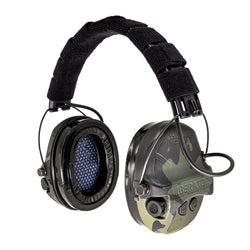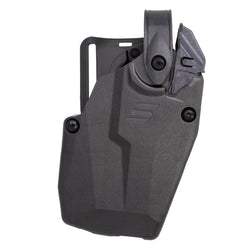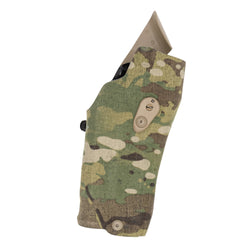The United States Marine Corps turns 250 this November 10. The Corps has a rich history that spans the globe, as represented on its famous insignia. Unfortunately, Hollywood mostly ignores the Marines until World War II, but from there, the Leathernecks have their share of cinematic exposure.
So, here, organized by representative time period, is one man’s list of favorite USMC-themed productions. Keep in mind that these are my subjective choices. We begin with World War II.
Sands of Iwo Jima (1949)
Sands of Iwo Jima is one of John Wayne’s great war pictures. The Duke plays a hard-nosed squad leader, fresh off the Guadalcanal Campaign, trying to get his unblooded Marines ready for combat. His men don’t always like him, but he’s effective. The squad hits the beach on Tarawa, one of the bloodiest, most difficult amphibious operations in history.
The combat scenes are better than you might expect for a 1949 movie. The individual scenes with the actors are standard for the time, and the Japanese soldiers are embarrassingly cartoonish, if nonetheless deadly. But the producers cut in generous slices of actual combat footage from the 76-hour fight for Tarawa Atoll’s Betio Island. The combination is very effective.

Following some character development that helps the movie’s ending, the squad ships out for Iwo Jima and the climactic assault on Mount Suribachi. Hollywood takes predictable liberties here that really only matter to guys like me. The squad would have been part of the 2nd or 8th Marine regiment at Tarawa, but the 28th Marines took Suribachi. None of the regiments from Tarawa took part in the Iwo Jima Campaign. But, again, that’s probably just me.
The Iwo Jima combat scenes also feature lots of real combat footage, including US Navy ships bombarding the island, aircraft carrier takeoffs, and airstrikes. Sands of Iwo Jima is a classic war movie that deserves to be rediscovered. The ending is even a bit touching.
Flags of Our Fathers (2006)
The second flag raising on Iwo Jima on February 23, 1945, is perhaps the most famous and visible event in Marine Corps history. Clint Eastwood’s Flags of Our Fathers, based on the book of the same name, follows the men involved in that iconic Marine moment, both on Iwo Jima and in the chaotic aftermath.
Iwo Jima was perhaps the most brutal campaign of World War II, and the flag raising on the island’s Mount Suribachi provided a morale boost for the Marines digging stubborn Japanese defenders from volcanic caves and fighting positions.

Joe Rosenthal’s classic photograph provided the basis for a major fundraising and propaganda campaign to fund the war effort, and the Marines involved became celebrities almost overnight. The movie follows those men, the controversy surrounding their identities, and how they dealt with the contrasts of fame of the stark reality of war on Iwo Jima itself.
Flags of Our Fathers was a box-office flop despite top-notch critical reviews. It’s a poignant, well-made film that dives much deeper than the standard war movie. Interestingly, the identities of the five flag raisers were not definitively confirmed until 2019, meaning that the movie, and the book, had a couple of them wrong. Nonetheless, this is a great movie that is worth your time.
The Pacific (2010)
The Pacific is a miniseries, not a movie. But I must include it here. It’s the second installment of three companion projects that include 2001’s Band of Brothers and 2024’s Masters of the Air. It follows several Marines through the Pacific War, beginning with the 1942 Guadalcanal Campaign. For the record, that campaign lasted until February 3, 1943, but the First Marine Division, in which the characters served, was there from August to December of 1942.

The Pacific is based on two war memoirs: Robert Leckie’s Helmet for My Pillow and Eugene Sledge’s With the Old Breed: at Peleliu and Okinawa. I personally consider Sledge’s work to be the finest, and most visceral, war memoir I’ve ever read. As stark as the series is, I promise you Sledge’s book brings it home even more powerfully.
The ten episodes follow the Marines on Guadalcanal, New Britain’s Cape Gloucester, Peleliu, and Okinawa, with a snippet of Iwo Jima. Leckie, “Sledgehammer,” and Sergeant John Basilone serve as the main characters, but we see their comrades like Gunnery Sergeant Elmo Haney and Merriell “Snafu” Shelton, among many others.
The combat and conditions are as accurate as Hollywood can make them, and the settings are authentic. I could write an entire article about how great this series is, but I’ll hold it to a few points. The actors portray real people, and they do a good job. You feel these guys, at least as well as we can, considering the places they fought are far beyond most of our experiences.
I was fortunate to spend ten days on Guadalcanal in 2023 and visited those battlefields, including the spot where Basilone earned the Congressional Medal of Honor. You can’t fully understand that place until you’ve been there. I think most battlefields are that way. The series brings those difficult realities home about as well as it can.

I like The Pacific better than Band of Brothers, though I admit it’s a matter of taste. I love both, but I think The Pacific is a little better because it shows how those Marines coped and readjusted to life after the war.
Sledge, in particular, had trouble, which actor Joe Mazzello portrays convincingly. His performance so moved the real Eugene Sledge’s family that they presented him with one of their father’s pipes that he carried during the war. It’s that good. I can’t recommend The Pacific highly enough.
The Boys in Company C (1978)
The Boys in Company C was among the first wave of Vietnam War movies, coming just three years after South Vietnam’s fall to the communist North. Set in 1967-68, the movie follows five Marine recruits who attend boot camp at San Diego and subsequently serve together in Southeast Asia. It was the first movie to depict combat in Vietnam since John Wayne’s not-so-great The Green Berets in 1968.
The boot camp scenes are reminiscent of a later, much better-known movie of which you may have heard: Full Metal Jacket. Like that film, The Boys in Company C employed real Marine drill instructors, including an up-and-coming actor named R. Lee Ermey, whose performance drew praise from film critic Roger Ebert, who liked the movie better than FMJ.

The men’s experience in Vietnam is well-documented, and the character interactions are good. The film’s time frame is deliberate, with the men arriving in time to participate in the 1968 Tet Offensive, which proved to be the war’s turning point because its images so shocked the American public. Like most Vietnam movies, don’t expect a happy ending, but The Boys in Company C is probably one of the best war movies you’ve never seen.
Full Metal Jacket (1987)
Stanley Kubrick’s Full Metal Jacket may be the best-known Marine Corps-themed movie in history for one reason: R. Lee Ermey’s performance as Gunnery Sergeant Hartman, the movie’s drill instructor.
As with The Boys in Company C, Ermey was hired as a technical advisor, but he was so good that he was offered the role himself. His opening monologue to his new platoon of recruits is legendary. The movie is based on Gustav Hasford’s semi-autobiographical novel, The Short-Timers. Hasford also co-wrote the screenplay.

FMJ’s Parris Island boot camp scenes (despite being filmed in England) steal the show, but the entire movie is told from the perspective of Private Joker (Matthew Modine), who we follow from Parris Island to South Vietnam. A military journalist for Stars and Stripes, Joker’s adventures in Vietnam coincide with the Tet Offensive, particularly the Viet Cong takeover of the city of Hue. Retaking Hue City was one of the Marine Corps’ major actions in Vietnam.
Like other Vietnam movies, FMJ’s ending is less than satisfying, just like the war itself. But the journey is worth your time.
Generation Kill (2008)
Like The Pacific, Generation Kill is a miniseries. It also deserves inclusion here. The Iraqi desert of 2003 is the polar opposite of The Pacific’s tropical jungles and heavily fortified islands, but as environments change, so do Marine tactics.
The 7-part series follows the Marine Corps’ 1st Reconnaissance Battalion during the 2003 invasion of Iraq, from its initial jump-off point all the way to Baghdad. Generation Kill is based on the book of the same name written by Rolling Stone journalist Evan Wright, who was embedded with Bravo Company’s Second Platoon for the dash to the Iraqi capital.

Gen Kill was filmed in Africa, giving it an authentic feel, and the combat scenes are solid. But the series’ real strength is the characters themselves. Again, these are real people being portrayed, with one guy, Rudy Reyes, playing himself. He was also a technical consultant, along with fellow Marine Eric Kocher, whose character is also in the series. Gen Kill shows us how real people adjust to almost unreal circumstances and persevere, sometimes despite themselves.
Another positive is the pop culture context within which these young men interact, reminding us again of their humanity. Yeah, the combat scenes can be intense, but good cinema is always character-driven. If you don’t come away quoting Sergeant Major John Sixta, I’ll buy you a beer.
Like The Pacific, I can’t recommend Generation Kill highly enough. The book is also excellent. You should read that too.
Megan Leavey (2017)
Megan Leavey popped up in my initial search for Marine Corps movies, but I had never seen it. I addressed that deficiency, and boy, I’m glad I did, because it deserves to be on this list. Based on a true story, the film follows the title character’s journey from a small, dead-end New York town through a quest to find herself via the Marine Corps.
Megan Leavey joined the Corps not long after the 2003 invasion of Iraq. She found her way into the K-9 unit, working with bomb sniffing dogs. Leavey ends up with a sometimes-difficult dog named Rex, with whom she deploys to Iraq in 2006. Leavey works overtime to bond with Rex, and they become an effective team.

The movie addresses the tension of such a high-stress job very effectively, and the brief combat scenes are well done. But the movie’s strength is Leavey’s fight to adopt Rex when she leaves the Corps. Rex had been labeled as too dangerous to adopt, but Leavey fought for her canine friend. She even went to the Senate to change his status.
This is a great movie. If it doesn’t touch your heart, well, I can’t help you. The dog doesn’t die, and the ending is happy. So, you have no excuses.
Semper Fi
So, there are seven movies to help you celebrate the Marine Corps’ 250 years. I have it on good authority that they have at least 420 more years to go.
I obviously left out a few movies, but I wanted to drill it down to what I thought were the best. But a few honorable mentions, which may have a few flaws, include A Few Good Men, Jarhead, Windtalkers, Retreat Hell!, and Battle: Los Angeles. That last one is among my guilty pleasures, along with other alien invasion films. If you want a laugh, and vintage Clint Eastwood, check out Heartbreak Ridge.
November is here, and the Corps’ birthday with it. So, sit back with your favorite beverage and enjoy some good movies. I know I will.









